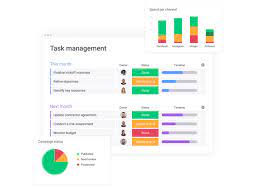Task Management Software: Streamline Your Workflow
In today’s fast-paced business environment, effective task management is crucial for staying organised and productive. Task management software offers a solution to help individuals and teams efficiently plan, track, and complete tasks in a systematic manner.
Task management software provides users with a centralised platform where they can create, assign, prioritise, and monitor tasks in real-time. By using such software, teams can collaborate seamlessly, share updates, set deadlines, and ensure that everyone is on the same page.
One of the key benefits of task management software is its ability to improve efficiency. With features such as task categorisation, progress tracking, and deadline reminders, users can better manage their workload and avoid missing important deadlines.
Moreover, task management software enhances communication within teams by providing a transparent view of project statuses and individual responsibilities. This transparency fosters accountability and enables team members to work together towards common goals.
Another advantage of task management software is its flexibility and scalability. Whether you are managing a small personal project or coordinating tasks across multiple departments in a large organisation, task management software can be customised to suit your specific needs.
Overall, task management software is a valuable tool for streamlining workflows, increasing productivity, and ensuring that projects are completed on time and within budget. By investing in the right task management software tailored to your requirements, you can take control of your tasks and achieve greater success in your endeavours.
Six Essential Tips for Maximising Efficiency with Task Management Software
- Choose a task management software that fits your specific needs and preferences.
- Prioritize tasks based on urgency and importance to stay organised and focused.
- Utilize features such as deadlines, reminders, and labels to keep track of tasks effectively.
- Collaborate with team members by sharing tasks, assigning responsibilities, and setting up notifications.
- Regularly review and update your task list to ensure it remains relevant and up-to-date.
- Take advantage of reporting tools to analyse productivity levels and identify areas for improvement.
Choose a task management software that fits your specific needs and preferences.
When selecting a task management software, it is essential to choose one that aligns with your specific needs and preferences. By considering factors such as the complexity of your projects, team size, preferred features, and integration capabilities, you can ensure that the software you choose enhances your workflow efficiency and helps you achieve your goals effectively. Tailoring your choice to match your unique requirements will maximise the benefits you derive from the task management software, ultimately leading to improved productivity and successful project outcomes.
Prioritize tasks based on urgency and importance to stay organised and focused.
To effectively manage tasks using task management software, it is essential to prioritise them based on both urgency and importance. By distinguishing between urgent tasks that require immediate attention and important tasks that contribute to long-term goals, individuals and teams can stay organised and focused on what truly matters. Prioritising tasks ensures that critical deadlines are met while also allocating time and resources to activities that have a significant impact on overall success. This approach not only enhances productivity but also helps in maintaining clarity and direction in achieving desired outcomes.
Utilize features such as deadlines, reminders, and labels to keep track of tasks effectively.
To maximise the efficiency of your task management process, make full use of key features like deadlines, reminders, and labels within your task management software. Setting clear deadlines ensures that tasks are completed on time, while reminders help you stay on top of upcoming deadlines and priorities. Additionally, using labels to categorise tasks based on their urgency or importance allows for easy identification and prioritisation. By utilising these features effectively, you can streamline your workflow and ensure that no task falls through the cracks.
Collaborate with team members by sharing tasks, assigning responsibilities, and setting up notifications.
To maximise efficiency and enhance collaboration within your team, utilise task management software to its full potential by sharing tasks, assigning responsibilities, and setting up notifications. By sharing tasks, team members can easily see who is working on what and avoid duplication of efforts. Assigning responsibilities ensures that each team member knows their role and contributes effectively to the project. Setting up notifications helps keep everyone informed about deadlines, updates, and changes in task status, fostering better communication and alignment within the team. Collaborating in this way using task management software can streamline workflows and drive successful project outcomes.
Regularly review and update your task list to ensure it remains relevant and up-to-date.
To maximise the effectiveness of task management software, it is essential to regularly review and update your task list. By consistently assessing and refining your list, you can ensure that it remains relevant and up-to-date. This practice helps you stay on track with your priorities, adjust to changing circumstances, and maintain clarity on what needs to be accomplished. Regular reviews also enable you to identify any overdue or pending tasks, allowing you to take timely action and keep your workflow organised and efficient.
Take advantage of reporting tools to analyse productivity levels and identify areas for improvement.
By utilising reporting tools available in task management software, individuals and teams can gain valuable insights into their productivity levels and pinpoint areas that may require enhancement. These tools enable users to generate detailed reports on task completion rates, time taken to complete tasks, and overall project progress. By analysing this data, users can identify bottlenecks, inefficiencies, or patterns that may be hindering productivity. Armed with this information, they can make informed decisions to streamline workflows, allocate resources more effectively, and ultimately improve their overall performance and efficiency.

